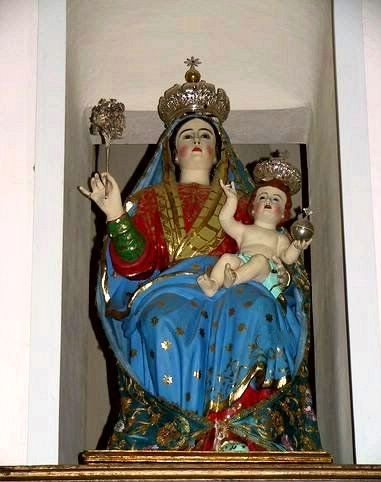Feast of the MaDonna Di Pierno
By: Tom Frascella August 18, 2013

San Fele MaDonna and Child
The feast day honoring Mary, Queen of Heaven, has been celebrated in the small village of San Fele, Lucania Italy each year since the year 1139 AD. Therefore, this year is its 874th anniversary celebration. In San Fele the day is known as the feast of the MaDonna Di Pierno.
The story of the feast begins about two centuries earlier in the ancient town of Atella a neighboring community. In the tenth century the people of Atella commissioned a wood carved statue of Mary as art for their local church. The statue produced was the image of a seated Mary with the infant Jesus on her lap, both figures crowned with a Byzantine style head dress, Imperial Crown.
This era of Italyís past was very unsettled, Muslim Saracens controlled Sicily and frequent Muslim raids were occurring along the coast of the Italian peninsula and into the interior trade routes. Alarmed by this and seeking a way to protect the statue in the event of a raid the people of Atella decided to hide the statue.
They chose an isolated and deserted mountain area as a hiding place. In this isolated area they found a cave on a mountain known as Monte Pierno and buried the statue there. The statue remained buried and protected for almost two centuries.
During the intervening two centuries the local southern Italian officials began recruiting Norman mercenaries as protection against Muslim incursions. Eventually, these mercenaries did gain the upper hand, invading Sicily in 1060 and defeating the last Muslim stronghold on the island in 1090. Because of this regionís mountainous geography the Mountain directly across from Monte Pierno became strategic location for a Norman military encampment which the Normans called a Fel. When all threat of Muslim invasion ceased the people of Atella began to consider recovering their hidden treasure on Monte Pierno. Recognizing that the Normans were unlikely to give up anything of value they decided to secretly recover the statue under cover of night. The secret recovery operation however was discovered and the Normans of the Fel would not release the statue. This caused great hostility between the two communities that erupted in to armed conflict.
The conflict between the towns foreshadowed a larger civil war between the assembled Norman forces and the established local population throughout southern Italy. The Normans prevailed and in 1139 AD as part of the negotiated peace the statue remained at the Fel. From that point on the area became known as the Saintís Fel or as the locals called it San Fele.
As San Fele is located at the southern most of the Appian mountain passes in ancient times a small but steady stream of travelers going from one coast to the other have passed through the area. These ancient travelers could find food and lodging at the small chapel and adjacent monastery which housed the statue. Over time devotional services began to attract pilgrims as well as locals. Today the religious site sees about 100,000 visitors a year who come to honor Mary.
In modern times among the more notable Marian devotees to visit and worship at the site have been St. Gerard Majella, St. Justin Jacobi, and Blessed Pope John Paul II.
The 874 years of continuous devotional celebration of Mary depicted as Queen of Heaven is the oldest such uninterrupted religious commemoration acknowledging her status in worldwide Roman Catholic tradition.
As people from the town of San Fele immigrated to other parts of the world they have continued to celebrate this feast day in their adopted countries and cities. The first time the feast was recognized with Catholic religious support in the United States was in 1889, 124 years ago on the lower East side of Manhattan. That religious procession which honored San Rocco also honored all of the patronal saints of Lucania. This of course included San Feleís MaDonna Di Pierno. Of note that first religious celebration saw the participation in procession of a young nun recently arrived from Italy name Francisca Cabrini.
Here in Trenton at what was historically the Italian National parish of St. Joachimís, the San Fele and entire local Lucanian community have celebrated the feast of the MaDonna Di Pierno each year since the beginning of the parish in 1901, or for the past 112 years. The San Felese community wishes to thank the pastor for the continued support of our historic Marian devotion and we look forward to continuing the tradition for many years to come.